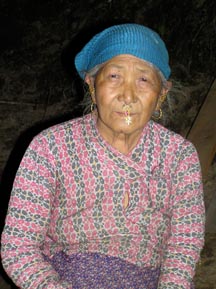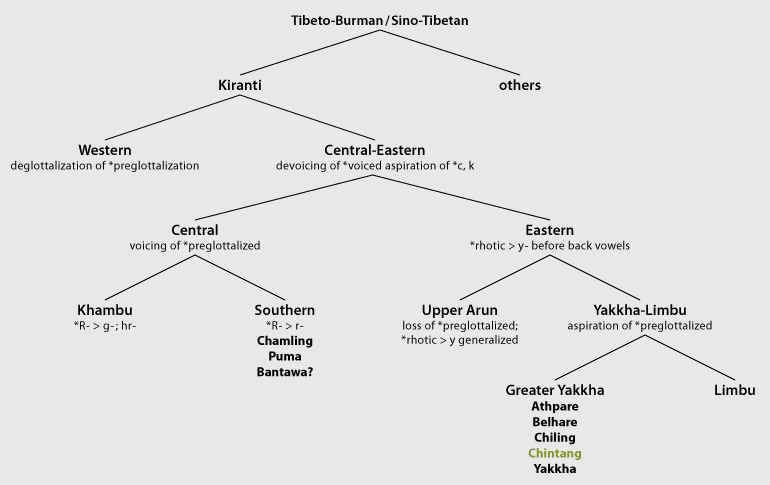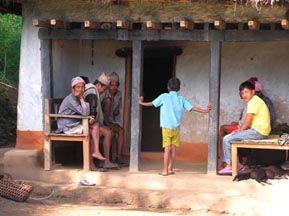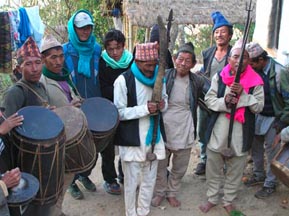The language
Chintang ([ˈt̻s̻ʰiɳʈaŋ], ISO 639-3 ctn) is a Kiranti language spoken by about 4,000–5,000 speakers in the Dhankuṭā district of Eastern Nepal. The name of the language is the name of the Village Development Committee (VDC) where it is mainly spoken. In Nepali it is commonly referred to as Chintāṅge Bhāṣā, literally ‘Chintangish language’. Apart from Chintāṅ VDC, the language is also spoken in a small part of the neighbouring VDC Āhāle.
Using the criteria for describing language endangerment put forward by the UNESCO’s Language Vitality and Endangerment framework Chintang gets the average vitality value 3 (values range from 0/extinct to 5/safe). The language is spoken by the majority of people living in Chintang in many contexts (excluding political discourse, education, and new media). The language is still often being transferred to children, although the number of children learning the language is decreasing and even fluent younger speakers replace more and more words with on-the-fly loans from Nepali.
As a Kiranti language, Chintang is part of the large Tibeto-Burman (Sino-Tibetan) family. Its closest relatives within Kiranti are the neighbouring languages Chiling, Belhare, and Athpare. Another neighbouring language, Bantawa, belongs to a different branch of Kiranti but is in intensive contact with Chintang.


The typological profile of Chintang can be largely derived from its embedding into the Kiranti family and especially its Eastern branch. Phonologically Chintang is inconspicuous: it has an average-sized phoneme inventory (6 vowels, 25 consonants) with the four-way contrast in stops typical of the whole South Asian region and the syllable structure (C)V(C). Chintang is, however, unusual by South (and Central) Asian standards when it comes to morphology and syntax. The language has a high degree of syntheticity (10 morphemes and more per word) and a wealth of morphological categories: nouns mark case, number, and possession, verbs index person, number, and clusivity of one or two arguments (depending on verb class and valency manipulation) and mark tense, mood, aspect, and polarity.
Both nouns and verbs have a complex morphological structure. There are 16 morphological cases (among them rare ones such as altitudinal locatives), many of which can be stacked to form composite meanings. Verbs have both prefixes and suffixes, with quite quite different properties. Prefixes are special in that they can be freely ordered and can host endoclitics. Most verbal affixes depart remarkably from the ideal of 1:1 correspondences between forms and functions, so there are many functions with multiple as well as with zero exponence and, similarly, many forms with several or no function at all. As a consequence of this the morphological information contained in a verb form is often more than just the sum of the functions of the individual morphemes. Verb forms can be made even more complex by combining normal verbs with special dependent verbs. An interesting morphological subsystem apart from nouns and verbs is presented by the small group of deictics. These words mark the relative location of an object including its altitude, its distance from the speaker, and subjectively perceived departures from standard distances.
The “basic” alignment pattern of Chintang is ergative, but this varies greatly across constructions and verb classes. Besides the morphological argument selectors of case and agreement, there are also many syntactic environments that treat one group of arguments differently from another, e.g. S/O detransitivisation, coreference constraints for non-finite forms, and marginal agreement in non-finite forms. There is a large number of mechanisms available for clause joining. Relative clauses are expressed by participles or polyfunctional nominalisers, which can also form complement clauses. A diverse set of forms, including converbs and conjunctions, is used for adverbial subordination. Among the most complex forms used in subordination is the infinitive, which goes hand in hand with exceptional case marking and various kinds of long distance agreement.


